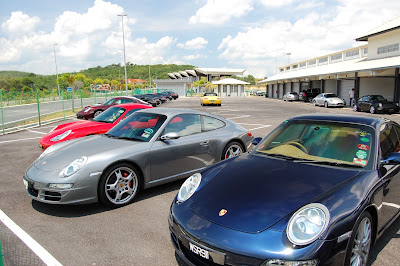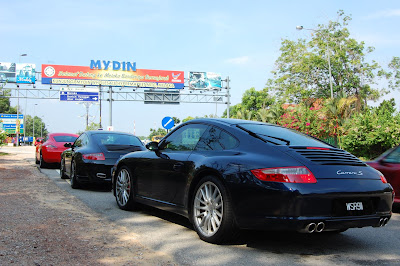





A decision on the race package from the options list, he is fully fit for the racetrack - the Audi R8 GT. The Ingolstadt place of this high-performance sports car limited to 333 copies of a series with impressive performance figures: 3.6 seconds from 0 to 100 km / h, 10.8 seconds to 200 km / h and a top speed of 320 km / h.
Here these values is an uprated engine of the standard R8 5.2 FSI Quattro technology and the lightweight of the Ingolstadt. If the weight of the R8 5.2 FSI Quattro with its aluminum space frame construction with permanent four-wheel drive Quattro and the optional R-tronic only 1625 pounds, brings the GT 1525 kg with 100 kg less now on the scale.
To this end, the engineers had to come up with stuff. There is a windshield of the GT is made of thinner glass, the glass partition between the passenger and engine compartment and the cell plate in the tailgate from light polycarbonate. These three changes take nine kilograms. The rigid rear wing is good for another 1.2 kilograms. With the aluminum patch over the luggage compartment in the bow could be through thin metal sheet and additional excerpts save 2.6 kilograms. The long tailgate is made of carbon fiber-reinforced plastic (CFRP) materials - an advantage of 6.6 kg. Additional 5.2 kg or 1.5 kg in control of the rear bumper and the sideblades, which consist of the same material.
Even with the technology components of the R8, the engineers were fighting for every gram booster when they brought a kilogram, in the aluminum pans of the brake discs of four kilograms and 9.4 kilograms of the battery. The module for the air intake, they found 2.3 kilograms and the insulation of the engine compartment 2.8 kilograms.
Inside, there was also considerable weight to lift potential. The new carpet is a light at 7.9 kilograms in the balance sheet, bucket seats, the chassis made of fiberglass-reinforced plastic (GRP), is at 31.5 kilograms. There were also many other detailed measures, such high-quality lightweight steel for the tailpipes of the exhaust system.
The design of Audi R8 GT combined power to express. That learned the exterior numerous modifications. Many of them also reduce the weight and improve aerodynamics. The R8 GT produced at high speeds even more downforce than the production model - without the drag coefficient would be increased from 0.36 and its frontal area of 1.99 m2 thereby. A highlight of the GT R8 are the LED headlights as standard. Their light is bright and homogeneous, their life and their high energy consumption low. Daytime running lights, each consisting of 24 LEDs appear as a continuous band.
The predominant element of the side view are the sideblades, direct the air to the engine. They also are the R8 GT in matte carbon. The same material used in the case of smaller mirrors are used, are the base made of aluminum. The 19-inch wheels carry an exclusive five-spoke Y-design in titanium finish.
At the rear are the revisions were particularly apparent integrated with the fixed Opaque carbon fins, the newly subscribed grilles on either side of the tailgate and the bumper made of carbon fiber in the large, circular exhaust tailpipes and exhaust vents for the wheel arches. The larger diffuser is made of carbon fiber composite material and the rear lights, built also in LED technology, have dark enclosure with clear glass panes.
The revised V10 with its red-painted cylinder head covers give the Audi R8 GT its power. Changes in the engine electronics to push the performance of the ten-cylinder engine by 26 kW (35 hp) to 412 kW / 560 PS. The torque curve peaks at 540 Newton meters (Nm) at 6,500 trips, 10 Nm more than with the standard version. On the naturally aspirated 100 km on average consumed 13.7 liters fuel.
The gear change in the R8 GT concerned the sequential gearbox "R tronic". The electrohydraulic clutch and shift unit receives its orders electrically. She changes her six speeds much faster than it could even an experienced driver - at high load and speed within a tenth of a second.
The central viscous coupling of the Quattro drive system, placed at the front axle differential distributes the forces under normal driving the V10 in the ratio 15: 85 between front and rear axle. This pattern blends perfectly with the weight distribution of Audi R8 GT, which is 43 to 57 percent. At the rear, a mechanical limited-slip differential improves traction.
The Audi R8 GT is a driving machine with stunning lateral acceleration and lightning-fast reactions. Its engine is in the middle, close to the vertical axis, its mass is therefore at fast changes of direction was not significant. The R8 GT goes into any situation dynamic, precise and stable.
The suspension follows the classic design from motorsport - double aluminum Dreiecksquerlenkerführen the wheels. The hydraulic power-steering rack is translated directly, with 16.3: 1. A manually adjustable coil-over suspension is standard. It sets the body up to 10 millimeters. Increased camber on the front and rear wheels enhance the handling qualities. The 19-inch forged wheels have the size 8.5 J x 19 front and 11 J x 19 rear, and are covered with tires in size 235/35 or 295/30.
Standard Audi mounted ventilated brake discs made of carbon-ceramic. You are standing and extremely wear resistant and very easy to build, with the same format they weigh nine kilograms less than their steel counterparts. The ESP can be switched by pressing a button on a sport mode that allows the throttle on corner exit a spectacular, but hard to oversteer. For a trip to the racetrack, the driver can switch off the system completely.
The R8 GT, the Audi in Germany for offering € 193 000, has a climate control and power windows, navigation system with MMI control logic and a powerful sound system on board. Optionally, a 465-watt sound system Ten point of Bang & Olufsen, a CD changer or the Audi Music Interface for election. The interior is decorated in a sporty black and dark gray.





















































